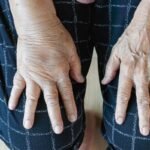It is common for anemia and menstruation to have a direct relationship in adolescence.
This is because adolescent girls often have heavy bleeding after menarche (the first period).
The explanation is that, often, the first menstruations tend to be anovulatory . That is, ovulation does not occur.
This is a result of the immaturity of both the ovary and the hormones responsible for regulating the menstrual cycle.
Since ovulation does not occur, the first phase of the cycle lasts indefinitely. This means that estrogen stimulation of the endometrium (the inner tissue of the uterus) lasts much longer than normal.
As a result, the endometrium continues to grow until it becomes so thick that it eventually sheds, causing heavy, prolonged blood flow.
In addition, the first menstruation is usually irregular, and periods may be very frequent.
This excessive bleeding (or menorrhagia ) can cause iron deficiency (iron deficiency) and subsequently iron deficiency anemia.
Although heavy periods may be expected during puberty, they should not be normalized.
Similarly, iron deficiency should not be underestimated, as iron deficiency has been associated with impaired physical and cognitive function.
Heavy bleeding during the first period can cause iron deficiency and, over time, the development of anemia.
Symptoms of anemia in adolescents
Initially, anemia in adolescents may be mild and go unnoticed.
However, as iron deficiency increases and anemia worsens, symptoms intensify.
Symptoms of menstrual anemia may include the following:
- Extreme fatigue
- Weakness and decay
- Bad mood and irritability
- Pale or yellow skin
- White eyes and lips
- Split, weak, and brittle nails. Anemia may be a cause of nail loss. Nails may also be yellow or a paler pink than normal. Another condition associated with iron deficiency anemia is spoon nails (a condition medically known as koilonychia). These are characterized by thin nails with edges that curl upward.
- Hair loss ( alopecia due to iron deficiency )
- Blurred vision
- Rapid heartbeat (tachycardia)
- Shortness of breath
- Headache
- Dizziness, vertigo, or feeling light-headed
- Cold hands and feet
- Inflammation or pain in the tongue
- Lack of appetite
- Absence of menstruation. Sometimes anemia disrupts menstruation, causing it to be delayed or disappear (amenorrhea).
- Unusual cravings for non-food substances. For example, ice, dirt, clay, or chalk. This behavior is known as ‘pica’ and is considered a symptom of severe anemia.
If any of these symptoms of anemia appear in adolescents, you should consult your doctor.
It’s worth emphasizing that even mild anemia can affect girls’ and young women’s energy levels, as well as their ability to concentrate and learn.
In this sense, it is important to remember that anemia and heavy periods are often directly related.
Therefore, in the case of a heavy menstrual flow, it would be necessary to assess whether the iron levels in the body are adequate.
How to treat menstrual anemia
The International Federation of Gynecology and Obstetrics believes that adolescent girls should be regularly screened for iron deficiency.
Not only by measuring hemoglobin (Hb) and hematocrit, but also serum ferritin (SF) and/or transferrin saturation (TSAT).
In this sense, whenever there is anemia in adolescents, heavy periods should be suspected.
Although treatment for menstrual anemia will depend on its severity, iron supplements are usually the first-line intervention.
- Iron food supplements
When iron deficiency in adolescents is mild or moderate, iron supplementation is recommended.
These iron supplements may provide only this mineral or also include other vitamins. For example, vitamin C and B vitamins.
Vitamin C improves iron absorption. B vitamins, meanwhile, contribute to the production of red blood cells.
In turn, both vitamin C and B vitamins can help improve some symptoms of menstrual anemia, such as tiredness and fatigue.
Iron supplements must be prescribed with specific instructions to optimize absorption.
Among these, avoid consuming them with foods rich in calcium and phytates, as these substances could impede their absorption.
Foods rich in calcium include dairy products (milk, cheese, and yogurt), green leafy vegetables, and canned sardines and salmon.
Phytates, on the other hand, can be found mainly in whole grains, legumes, and nuts.
The dosage will depend on the state of iron stores, whether a preventive effect is sought, or whether anemia has already set in.
Thus, taking iron positively affects menstruation, as it can prevent and treat anemia in cases of heavy bleeding.
Some authors recommend taking an iron supplement of 10-15 mg per day during menstruation until the pubertal spurt ends.
Supplements must have optimal tolerability to improve treatment adherence.
- Hormonal contraceptives
If bleeding is very heavy, hormonal contraceptives may be prescribed.
Beyond iron deficiency anemia, these medications can relieve other symptoms such as severe menstrual pain.
Hormonal contraceptives thin the lining of the uterus (endometrium) and cause it to shed regularly.
This prevents the endometrium from growing too much and causing heavy blood loss.
- High-dose hormone treatments
Only in very specific cases may high-dose hormone treatment be required to reduce menstrual bleeding.
How to prevent iron deficiency in adolescents
It’s worth remembering that iron needs increase during childhood and adolescence, and that this mineral plays a role in many bodily functions.
In this sense, iron is vital for young people to be able to undergo the growth acceleration and changes in body composition typical of this stage.
It is estimated that between the ages of 10 and 18, 15-25% of adult height and 40-45% of adult weight are acquired.
At the same time, puberty sees an increase in bone and muscle mass and an expansion in total blood volume. The latter, in turn, leads to an increased need for iron.
Finally, adolescence is a stage where there may be intense sporting activity and greater cognitive effort , due to academic demands.
All of these factors can also contribute to iron deficiency and the development of this type of anemia.
In this context, girls and young adolescents are up to 10 times more likely to develop anemia than boys at this stage.
This is due to the arrival of menstruation and the changes it can cause in the early years, primarily heavy bleeding.
For all these reasons, it is essential to know how to prevent anemia in adolescents.
At the same time, we must not forget the importance of iron in the immune system and in preventing recurrent infections.
Balanced diet
It is essential that adolescents follow a balanced diet that ensures an adequate intake of energy (calories) and nutrients.
Adolescence can be a complex stage in terms of eating habits, but we must ensure that they are as healthy as possible.
Restrictive diets or starting dietary guidelines on your own should also be avoided.
Healthy weight
Obesity has been associated with low blood iron concentrations in children and adolescents.
This is because they usually present high amounts of hepcidin, a hormone that inhibits iron absorption.
Therefore, maintaining a healthy weight can act as a protective factor.
Foods rich in iron
The diet must provide sufficient iron to cover the needs of adolescence.
These include red meat, cockles, and clams, as well as legumes, nuts, dried fruits, and fortified cereals.
Foods rich in vitamin C
Eating foods high in vitamin C along with sources of iron helps increase its absorption.
These include red peppers, citrus fruits, tomatoes, broccoli, and leafy greens.
This is especially important when consuming plant sources of iron, since its absorption is lower.





















+ There are no comments
Add yours